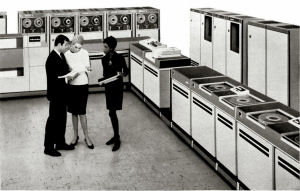|

The basic NCR Century 100 System consists of a central processor, high-speed memory, a dual-spindle disc unit, a printer, and a punched card or punched tape reader. The disc unit,  printer, and card or tape reader are integrated peripherals; that is, all the logic required for controlling these units is an integral part of the central processor. printer, and card or tape reader are integrated peripherals; that is, all the logic required for controlling these units is an integral part of the central processor.
The processor comprises an arithmetic logic unit (ALU) and an input/output control unit (I/O Control). The I/O Control contains the logic circuitry required to handle communication between the processor and each of its peripherals. This communication takes place over two lines, designated Trunk 0 and Trunk 1. Each trunk can handle eight peripheral units, with certain positions reserved exclusively for integrated peripherals and the remainder available for freestanding units. The NCR Century common trunk concept specifies a standard interface logic that permits the processor to communicate with NCR Century peripherals, regardless of type or function, through any open position on either trunk.
The I/O Control section of this publication contains a detailed explanation of NCR Century processor/peripheral communication.
NCR Century I/O operation is initiated by the ALU, using information derived from an I/O command. After the ALU completes the selection sequence it returns to processing subsequent program instructions, leaving the I/O Control portion of the processor to direct data transfer. Should the next command in sequence be another INOUT command designating a peripheral attached to the second trunk, the procedure is repeated. Peripheral operation on either trunk must terminate before another peripheral can be selected on that trunk.
Data is input and output serially, by byte. The parity bit is checked by the I/O Control when data is received from the peripheral, and by the peripheral unit itself when it receives data from the processor. Six or eight memory cycles are normally required to transfer one byte, depending upon the peripheral and trunk.
NCR Century 100 logic is such that, if the I/O Control and the ALU request a memory cycle at the same time, the I/O control takes priority. Since peripheral servicing does not require all the memory cycles available within a given time frame, the ALU "steals" unused cycles and continues processing during data transfer. This characteristic provides the NCR Century 100 with effective three-way simultaneity; that is, it is possible for two I/O operations and an ALU operation to take place in a given space of time.
|

